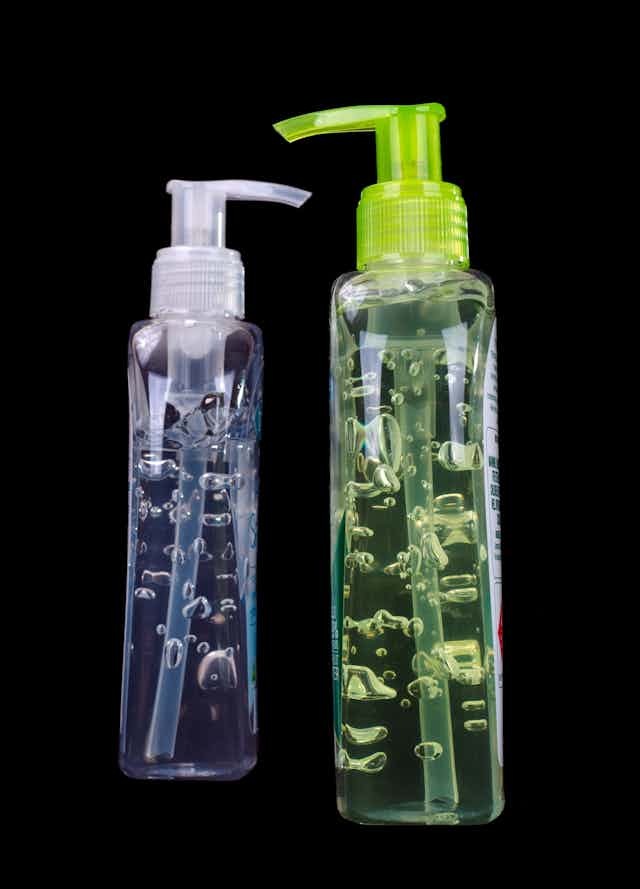Hand sanitisers have become a popular way to stop the spread of germs; portable alternatives to soap and water. But how can you tell whether your hand sanitiser is actually doing its job? The Conversation Africa’s Health and Medicine Editor Joy Wanja Muraya spoke to Ochwoto Missiani and James Kimotho, researchers at the Kenya Medical Research Institute, about the quality of hand sanitisers in the Kenyan market
So how do hand sanitisers work?
Hand sanitisers, also known as waterless hand hygiene, work by killing the disease causing germs on our hands. They have become popular where there is limited water and soap.
Hand hygiene is an effective public health practice; it can help to prevent infections in hospitals and in communities. Unfortunately it’s not always applied. A study done in three Kenyan hospitals surveying the most common infections associated with hospitals found that patients admitted to intensive care units – and particularly children – were especially prone to viral infections.
This was attributed to poor hand hygiene among hospital staff when handling patients.
Alcohol-based sanitisers are recommended for use in hospitals by health workers and by the general public. This is because at concentrations of between 60 and 80%, alcohol destroys the proteins in germs that cause disease and infections, especially bacteria and fungi.
Alcohol concentrations of higher than 80% are less potent in killing bacteria.
Advertisements in the media promote certain soaps and hand sanitisers claiming they kill 99.9% of germs. These brands have become popular among Kenyans. We decided to put these claims to the test – and found that half of the hand sanitisers available in Kenya are substandard.
How did your study work?
The production department at the Kenya Medical Research Institute led this laboratory based study. We randomly picked 14 hand sanitiser brands from different retail outlets and hospitals in Kenya. At least one and a maximum of four different batches of each brand was picked.
To test their efficiency in line with global production standards for efficient hand sanitisers, 35 participants sampled the brands’ germ killing power.
We tested the efficacy of the hand sanitisers through several steps as described in the European Standard (EN) 1500:2013 (Plate 1):
The hand rub samples were fully concealed from the participants. The containers were wrapped in identical opaque papers and coded accordingly, with the cap left open for easy access during the testing;
The participants washed their hands as recommended with soap and water, drying them with paper towels. Then they dipped their four fingers into a non-disease causing bacteria and then touched a sterile broth suspension;
The participants washed their hands as recommended with soap and water, drying them with paper towels. They then dipped their finger into a non-disease causing bacteria and applied the hand sanitiser.
After one minute, they touched a sterile broth suspension (Plate 2).
- We incubated both plate 1 and 2 of the three types of non-disease causing bacteria overnight to check for any bacteria growth the next day. The number of bacteria growth, the colony forming units, before sanitising (in Plate 1) and those in plate 2 (after sanitising with respective hand sanitiser) served as a pre-value and post-value respectively. The difference between pre and post value determined the efficacy of the hand sanitisers.
What did the results show? What does this mean?
Only four products, 28.6 % of those sampled, showed 99.9% efficacy in killing bacteria and thus met the global standards on the quality of hand sanitisers.
Half of the 14 hand sanitisers could not kill 50% of the three different bacteria strains hence failing to meet the requirements for alcohol based hand rubs of 50% bacterial reduction.
We also noted that a product containing both alcohol and triclosan was effective in reducing E. Coli (99.9%) bacterial reduction, but was not effective on the other two bacteria types: Staphylococcus aureus and Pseudomonas aeruginosa (52.9% and 62.3% respectively).
Another product with a combination of ethyl alcohol and aloe vera was the least effective of all the products sampled.
What is the way forward?
The poor quality of hand sanitisers in Kenya poses a public health concern. If this market remains unregulated these products might encourage the undetected transmission of infectious pathogens in hospitals.
Manufacturers should conduct routine efficacy tests on their products before they are marketed for use. Substandard hand sanitisers should be banned because they give the consumer a false sense of protection against the disease causing germs.
They will also be expected to specify the type of “germs” their product targets: bacteria, viruses, or both?
Kenya needs to actively implement its existing regulations on the production and distribution of hand sanitisers.
These statutory regulations will ensure that each company provides data about their products’ efficacy and stability. Random testing of hand sanitisers already in the market to check on their adherence to the recommended efficacy levels is advised.
Consumer education is also a powerful way to ensure the general public is aware of the most efficient hand sanitisers.

